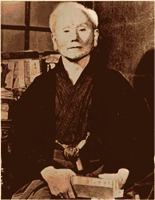Principles of Shotokan Karate by: Unknown
"The ultimate aim of the art of karate lies not in the victory or defeat, but in the perfection of the characters of it's participants." - Gichin FunakoshiKarate Philosophy
Japanese martial artists have discovered that there are no limits to physical development, and to surpass those limits one must depend on mental development. Therefore, martial artists try to live and control their lives by the mental development and the mental concepts they practice. When the weaponless combat technique of Okinawa was introduced on the Japanese mainland by Ven. G. Funakoshi., it was strongly influenced by Japanese Zen philosophy, as were other martial arts. This influence has meant that karate goes far beyond mere fighting techniques. The essence of Zen philosophy is the process of eliminating one's ego -- of attaining a state of mind that is affected by nothing -- a state of mind that is, in itself, a state of nothingness. The real meaning is clear when, after much practice, one finally does arrive at that state of mind which is disturbed by nothing. This state of mind benefits one through better concentration and control, not only in Karate but in all aspects of one's life, such as academics or job performance.Traditional Karate
The art known as kara-te (empty hand) was once called Okinawa-te (Okinawan hand). Okinawa is located midway between Japan and China. Around four hundred years ago, King Shohashi united Okinawa and ordered the burning of all weapons to prevent armed uprisings. Two hundred years later, the Satsuma clan from the Japanese main island of Kyushu conquered Okinawa, and again renewed the ban on weapons. In response the islanders developed an unarmed system of self-defence so effective that the island rebels could kill a Japanese warrior in leather armor with one strike at a vital point. This early form of karate was influenced by the Chinese martial arts, as was Okinawa's culture, due to it's location between China and Japan. As Okinawa merged politically and culturally with Japan, the art of karate became popular there, primarily through the efforts of Master Gichin Funakoshi (1868 - 1957) who founded the style known as Shotokan. Karate spread worldwide after World War II.Traditional karate is a martial art (budo), in which the primary goal is not aggression, but self improvement. The power of karate comes not from muscle strength, but understanding of body dynamics and mental focus (kime).
Kime is the synchronization of the entire body to support the point of contact with the opponent. It is kime which allows the karate student to master the finishing blow. A finishing blow (todome) is one technique, whether punch, kick, or strike, sufficient to incapacitate an opponent. This technique is facilitated by the extension of mental energy (ki) which is developed through concentration and control.
Karate training is based on continuous effort to improve, both physically and mentally. The process of improving in karate is based on eliminating one's ego and attaining a calm state of mind. This clarity of mental function and self-confidence benefits the student not only in karate but also in all aspects of life, including job performance and academics. Kicking, and punching alone are a small part of the art of karate.
